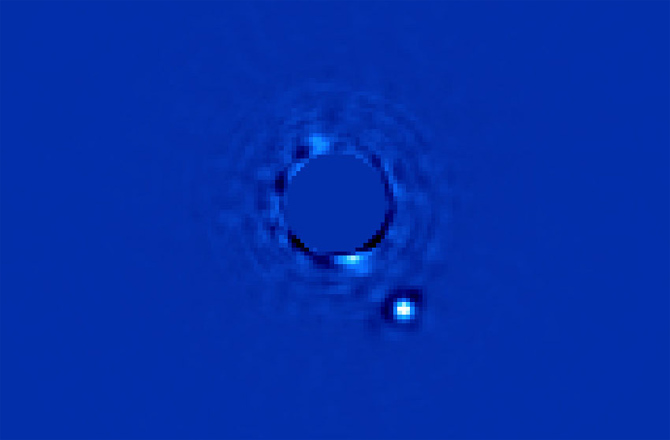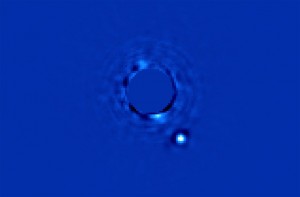January 9, 2014 – With our apartment in topsy turvy because of the flood of last week an exoplanet is looking pretty good right now as a place to move to. These last few months have seen a number of new exoplanet findings. We even got a picture of one in the last few weeks using the Gemini Planet Imager (GPI), a new Earth-based camera mounted to a telescope which captured infrared imagery of an exoplanet orbiting the star Beta Pictoris. In the image below the camera has masked the light from the star to reveal the planet.
Dubbed Beta Pictoris b, it is several times larger than Jupiter and according to the astronomers approximately 10 million years old. They know this because they can measure the heat the planet emits creating a significant glow in infrared light. Analyzing the light further has given these astronomers a picture of Beta Pictoris b‘s atmosphere.
But keeping in theme with the flood we experienced on the weekend, let’s talk about waterworlds that are exoplanets classified as super-Earths. A super-Earth is almost the size of Neptune and certainly larger than our planet. But unlike Neptune super-Earths are not mini-gas giants, but rather, rocky planets containing a significant amount of water content. If that water were only on the surface then indeed these planets would be waterworlds. But in fact the scientists hypothesize that like on Earth, much of the water is tied up under the crust.
How does water go from the surface to the mantle rock inside the planet? On Earth plate tectonics is the mechanism. The movement of continental and ocean-bottom plates acts like a recycling mechanism over time. The rock from the surface containing water eventually dips into the mantle where it becomes buried deep inside the planet. If plate tectonics is found to be a mechanism on other planets then these too would have significant amounts of buried water.
That is what a new study entitled, Water Cycling Between Ocean and Mantle: Super-Earths Need Not be Waterworlds, appearing in the January 2nd, 2014 issue of The Astrophysical Journal, argues. The authors state that previous views of super-Earths as largely being waterworlds with deep oceans and limited land surfaces is incorrect. Instead they believe that many super-Earths go through a similar cycling process as found here on Earth and it is that process that makes them potentially habitable.
Nicolas B. Cowan, a postdoctoral fellow at Northwestern University’s Center for Interdisciplinary Exploration and Research in Astrophysics states, “We can put 80 times more water on a super-Earth and still have its surface look like Earth….these massive planets have enormous seafloor pressure, and this force pushes water into the mantle.” With exposed continental land masses far more extensive than ours here on puny Earth, the chances of creating an Earth-like climate on a super-Earth are highly likely.
As new telescopes and technology gets introduced we should be able to test this hypothesis as we attempt to classify the growing number of planets that one day humans may want to visit virtually or in the flesh.















